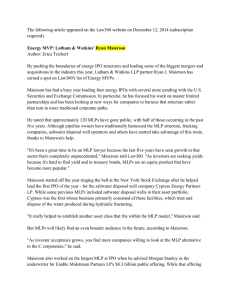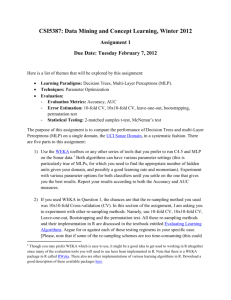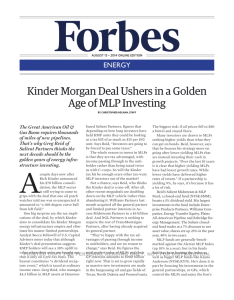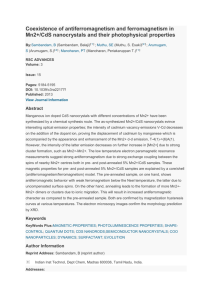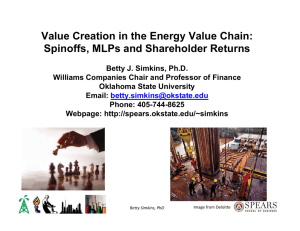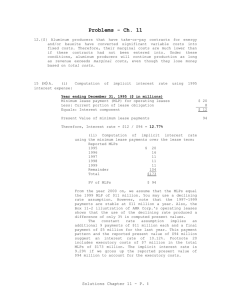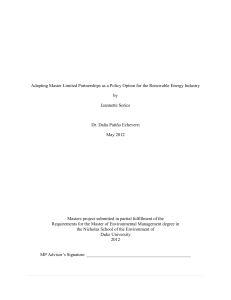Understanding the Master Limited Partnership Market and its Impact
advertisement
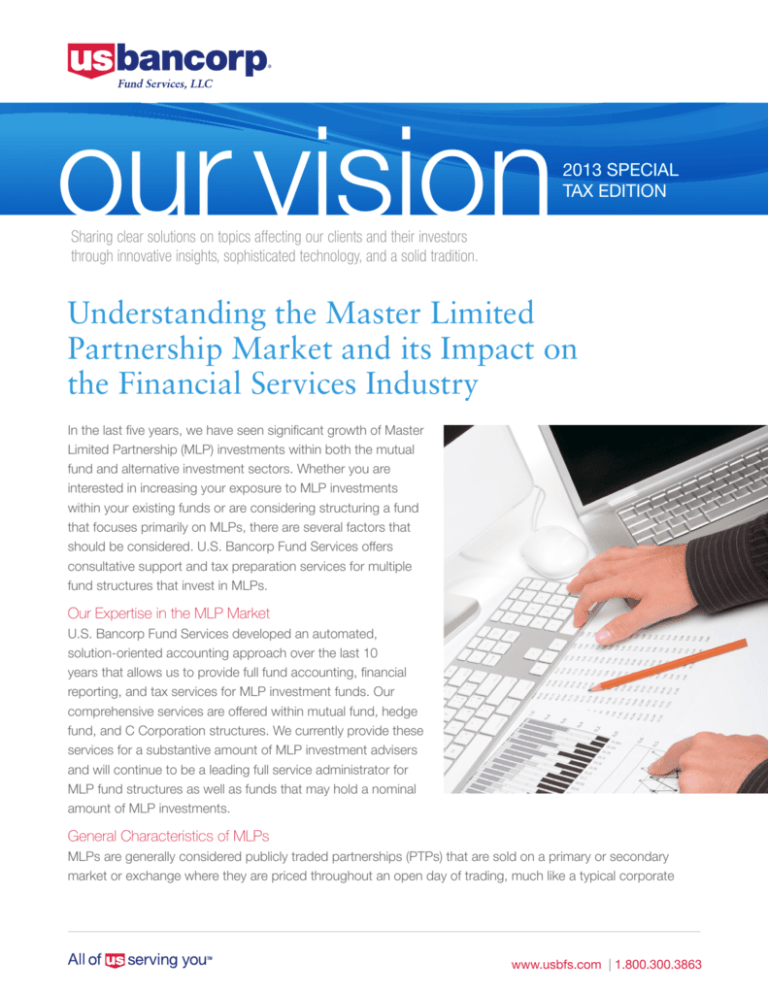
our vision 2013 SPECIAL TAX EDITION Sharing clear solutions on topics affecting our clients and their investors through innovative insights, sophisticated technology, and a solid tradition. Understanding the Master Limited Partnership Market and its Impact on the Financial Services Industry In the last five years, we have seen significant growth of Master Limited Partnership (MLP) investments within both the mutual fund and alternative investment sectors. Whether you are interested in increasing your exposure to MLP investments within your existing funds or are considering structuring a fund that focuses primarily on MLPs, there are several factors that should be considered. U.S. Bancorp Fund Services offers consultative support and tax preparation services for multiple fund structures that invest in MLPs. Our Expertise in the MLP Market U.S. Bancorp Fund Services developed an automated, solution-oriented accounting approach over the last 10 years that allows us to provide full fund accounting, financial reporting, and tax services for MLP investment funds. Our comprehensive services are offered within mutual fund, hedge fund, and C Corporation structures. We currently provide these services for a substantive amount of MLP investment advisers and will continue to be a leading full service administrator for MLP fund structures as well as funds that may hold a nominal amount of MLP investments. General Characteristics of MLPs MLPs are generally considered publicly traded partnerships (PTPs) that are sold on a primary or secondary market or exchange where they are priced throughout an open day of trading, much like a typical corporate www.usbfs.com | 1.800.300.3863 2013 SPECIAL TAX EDITION our vision stock. PTPs are traded in units rather than in shares, but because of their corporate open market trading characteristics, they can be classified as corporations for U.S. financial reporting and tax purposes. The IRS allows MLPs that derive 90 percent or more of their annual gross income amount from passive sources to be classified as Qualified Publicly Traded Partnerships (QPTPs). While PTPs that fail to qualify as QPTPs are taxed as corporations for U.S. tax purposes, QPTPs are taxed as partnerships. Because QPTP classification is based on an annual fiscal gross income test, MLP designation as a taxable corporation or partnership can change, and therefore must be monitored. MLPs that are U.S. corporations for tax purposes issue annual 1099 income reporting statements to their underlying investors, while MLPs taxed as partnerships issue K-1 statements. Currently, a significant portion of MLPs are classified as oil, gas, or other types of energy exploratory companies. Per the National Association of PTPs (NAPTP), there has been significant growth in total U.S. MLP structures over the past five years. See the illustration below for the current industry composite of MLPs. For funds that invest in MLPs, the NAPTP website also currently lists within the financial services industry 15 active open-end MLP Funds and 25 closed-end MLP Funds. There is also an aggregate of 19 MLP exchange traded fund (ETF) and exchange traded note (ETN) structures. In the current MLP industry environment, a majority of energy MLPs typically qualify on an annual basis as QPTPs and are therefore taxed as partnerships rather than as corporations. MLPs also generally make quarterly cash distributions to their underlying unit holders. For the underlying investors that receive these distributions, only a small portion of the quarterly distributions are generally designated on year-end reporting statements as taxable income distributions, while the remaining portion of the taxable character is classified as return of capital (ROC) distributions. The ROC portion of these distributions is generally considered a tax deferred attribute of MLP quarterly distributions. These significant ROC distributions are due to favorable accelerated depreciation expenses for energy pipeline developments and other U.S. tax credits that can be applied to offset MLP taxable income amounts. www.usbfs.com | 1.800.300.3863 2013 SPECIAL TAX EDITION our vision Some MLP analysts currently project these investments to yield a return on investment between a 5 to 7 percent range, which has been very attractive to many investors given the current lower annual yields within most bond and other fixed income markets. The MLP market within the United States continues to expand as new pipelines are developed, especially within the Permian basin, the Gulf Coast region, and throughout our western states. The United States is also expanding its role as a net exporter of energy products to many regions including Mexico and Western Europe. Analysts have also noted recent expansions in new energy markets including shale, petro chemicals, and natural energy sectors such as solar and windmill products. All of these attributes noted within the MLP energy sector suggest continued growth and expansion within this market. Special Accounting and Reporting Considerations for Investments in MLPs Given their unique characteristics, the following considerations should be examined for MLP investments: »» Most MLPs are taxed as U.S. partnerships and generate Schedule K-1s, which can create timing issues for calculating and estimating taxable income with an investment fund’s fiscal year. Certain fiscal year-ends can be elected that are more favorable if significant MLPs are held, and efforts may need to be made to estimate K-1 income from MLPs through their prior annual K-1 income statements. »» Recently proposed IRS regulations attempt to limit mutual fund exposure to MLP investments from 50 percent to 25 percent of total gross assets. As a result, there may be a trend for new MLP-focused funds to be structured as C Corps and hedge funds. »» MLP funds can generate ordinary income from a trade or business. This can greatly enhance state reporting obligations and trigger in-depth analyses that must be performed at the state level. »» Accounting systems for MLP investments must be designed to appropriately allocate K-1 income equitably among multiple purchase lots held for the same MLP investment for calculating tax basis for each lot and capital gains or losses from the sale of MLP lots. www.usbfs.com | 1.800.300.3863 2013 SPECIAL TAX EDITION our vision »» MLPs that are designated as corporations for tax purposes can trigger a favorable Dividend Received Deduction income tax reduction from the quarterly distributions paid by MLP funds. »» K-1 information received from MLPs must be thoroughly reviewed in determining their Earnings and Profits (E&P), which in turn may impact reportable taxable income amounts received from quarterly distributions. »» The IRS passive loss limitation rules require an analysis to be performed to ensure losses from MLPs are recorded at the individual MLP level and are not netted together at the MLP fund level for tax purposes. »» Because MLPs can generate ordinary income from a trade or business, they may generate Unrelated Business Taxable Income (UBTI) to qualified tax-exempt investors depending on the type of MLP fund investment structure. »» MLPs must be reviewed annually to determine whether they qualify as QPTPs. BUILDING ON FOUR DECADES OF INVESTMENT EXPERIENCE With nearly 45 years of service distinction, U.S. Bancorp Fund Services combines industry-leading technology with high-quality customer service to provide our clients with customized solutions. The core of our business model has relied on the passion and experience our professionals bring to the office every day. With extensive industry tenure and knowledge encompassing every type of mutual fund and alternative investment product and strategy, our professionals’ vision, combined with our sophisticated technology, gives our clients the guidance, resources, and insight into the market they need to be successful. Please contact your U.S. Bancorp Fund Services fund administrator, relationship manager, or Michael McMaster, U.S. Bancorp Fund Services Tax Director (414-765-6871) for any further information regarding our full suite of services for MLPs. This document is for general discussion purposes only and is not intended to be used or construed as tax advice, and cannot be used by the recipient for the purpose of avoiding penalties that may be imposed under the Internal Revenue Code or applicable state or local tax law provisions. U.S. Bancorp Fund Services, LLC 615 East Michigan Street Milwaukee, WI 53202 www.usbfs.com | 1.800.300.3863 U.S. Bank does not guarantee the products, services, or performance of its affiliates and third-party providers. 103113
